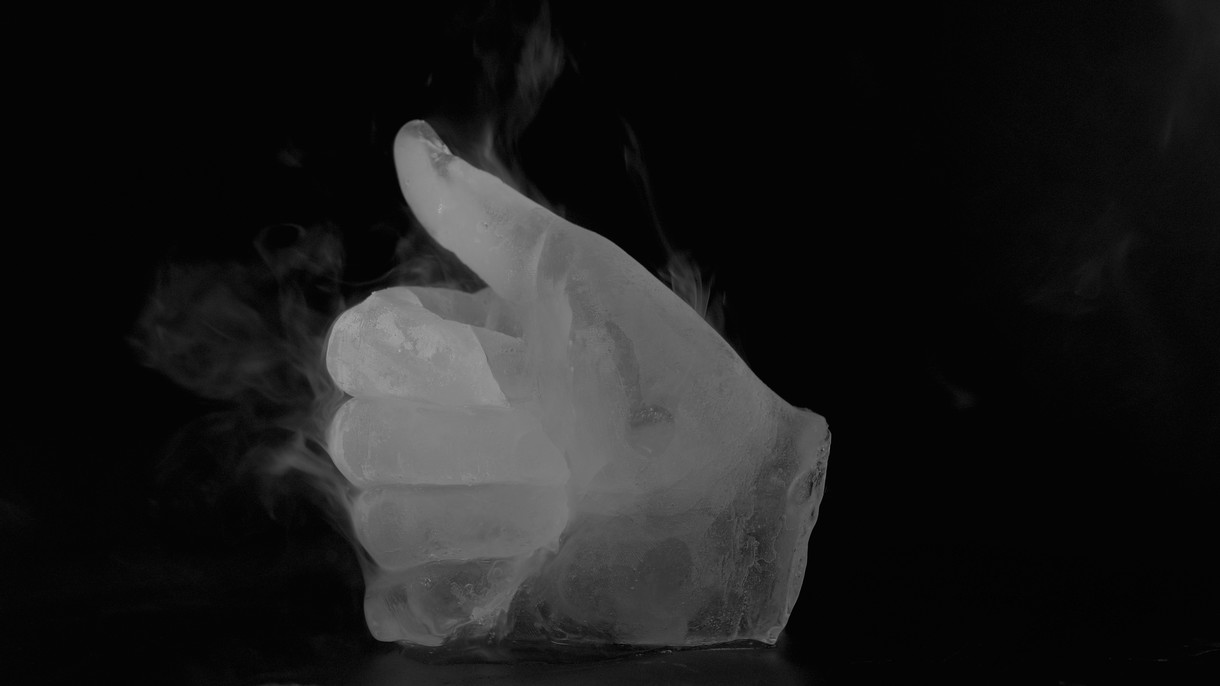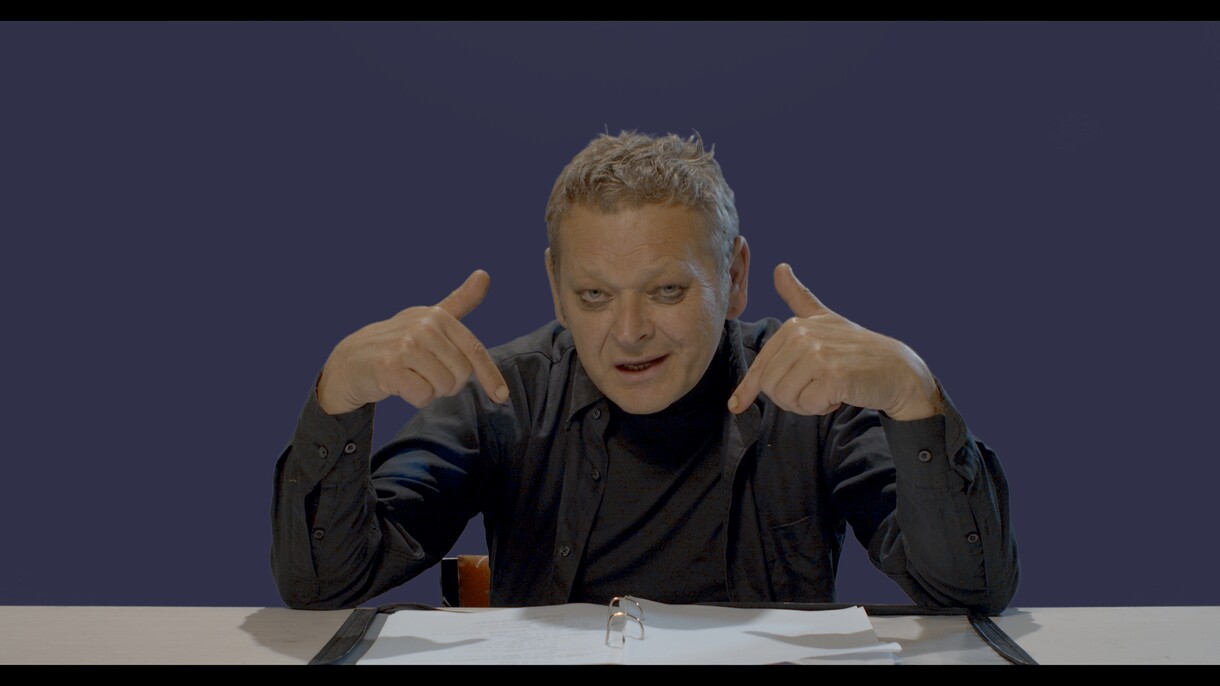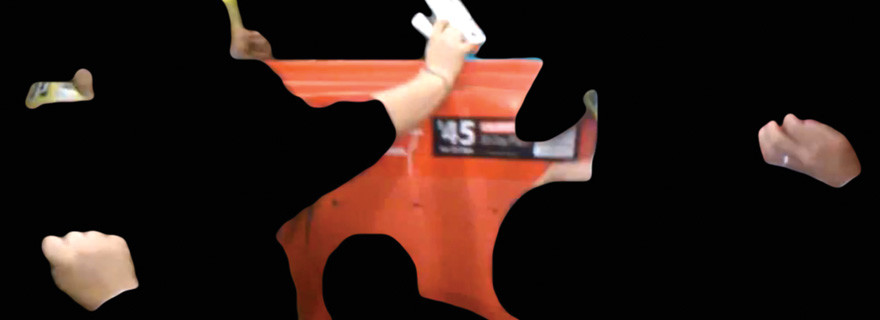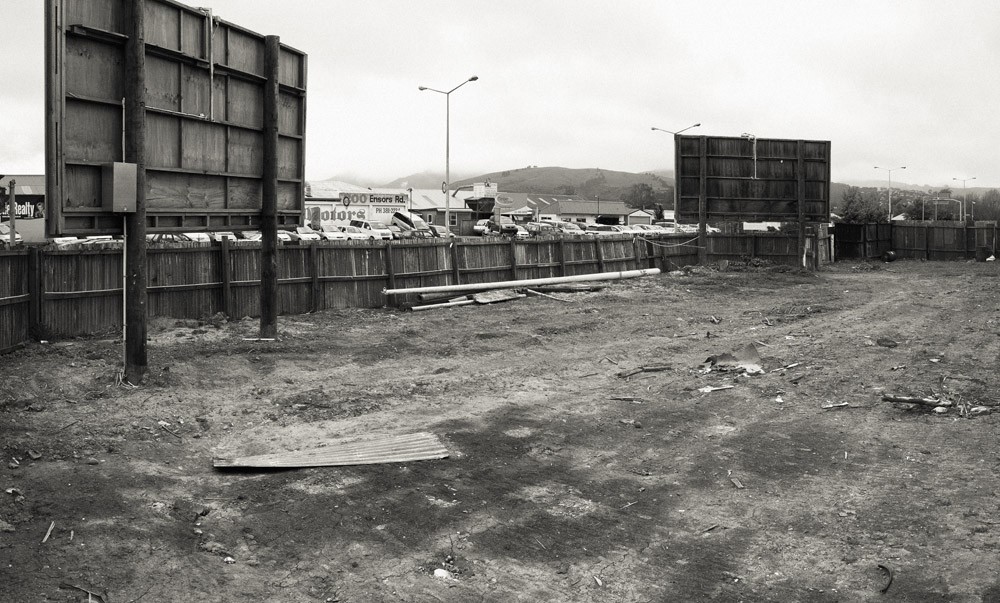James Oram: By Spectral Hands

James Oram Currency (video still) 2022. Two-channel 4K video. Courtesy of the artist
In the American psychological thriller Severance, the employees of Lumon Industries undergo a surgical procedure that separates their work and non-work memories. The uncanny plot unfolds into what feels like a terrifyingly accurate portrayal of the power that corporations exert over our lives, and the integration of the self into capitalism. In this fictional world Mark and his co-workers willingly join the corporation, blind to what it is they do as part of the Macrodata Refinement team. The series offers insight into how data has become a core part of capitalism, despite the over-abundance of information in a system founded on scarcity. Further, Severance’s data sorters must categorise and file the numbers that appear on their computer screens based on their emotional response to them, rather than applying logic, thereby integrating their feelings to the digital realm.
An awareness of our willing participation in a capitalist system that has swallowed the potential of digital technologies and human emotion also underpins James Oram’s By Spectral Hands. Oram’s sculptural and video works use the marketing techniques and mechanisms of consumer capitalism to offer a physical interpretation of the way that consumer demand is manipulated to generate industrial and commercial profit. The exhibition consists of four aspects, which together form a whole that Oram thinks of as an ecosystem: a tactile transducer sculpture that turns an audio recording of the theories of Edward Bernays into vibrations in water; a brass wireframe divider; cyanotype blueprints of hands; and a two-channel video work of a frozen thumbs-up. Each component has a distinct relationship to the psychology of promotional strategies, from display systems to information architecture, advertising imagery and customer engagement symbols. Yet the works are also based on unstable forms in a state of transition – moving, fading, melting, freezing or evaporating – and play off one another as a dynamic system of interlocking parts. The free market, which is generally represented as an abstract stock exchange correlating the rise and fall of share prices to real labour, materials and products, is an ever-present yet invisible force that runs through the exhibition. However, Oram also reveals with each work how our bodies, emotions and thoughts are exploited within the capitalist economic system.
Generally known as the father of public relations, American publicist Edward Bernays (1891–1995) wrote his key work Propaganda in 1928, and his ideas led to the development of contemporary marketing and communication strategies. The nephew of prominent psychoanalyst Sigmund Freud, Bernays saw the potential for his uncle’s psychology to be applied to the commercial sector through what he termed “the engineering of consent”. In the early twentieth century he used these ideas to manipulate consumers by manufacturing desire based on human instincts like fear, lust and jealousy, rather than need. One of his earliest campaigns was for the American Tobacco Corporation where he was charged with encouraging women to smoke cigarettes – or, as Bernays called them, “torches of freedom”. He strategically placed cigarettes in the mass media and aligned smoking with power, freedom and beauty, and women across the United States soon adopted cigarette smoking as a fashionable accessory and sign of sophistication. His marketing techniques could have been utilised to change public opinion and behaviour for the better (today one might like to think they would be used to make us respond to climate change or demand a fairer democracy) but primarily Bernays taught companies to exploit the irrational emotions of the masses to sell more products and gain political influence.
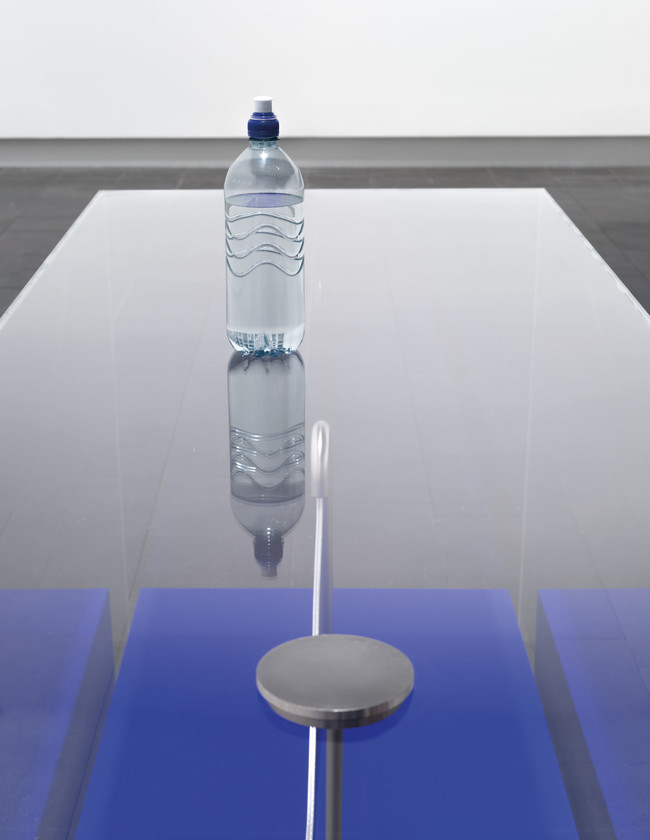
James Oram Edward’s noisy ghost (detail) 2022. Water bottle, tactile transducer, audio recording of Edward Bernays, Propaganda, 1928. Courtesy of the artist
A half-full bottle of water rests on a transparent display counter. Inside the cabinet a tactile transducer, a piece of equipment that turns sound into movement, plays an audio of Bernays’s theories at a very low frequency, transforming his ideas into vibrations that cannot be heard but are seen as ripples in the water. There is something ominous about this silent movement, since we cannot observe what is causing the disruption. I am reminded of the subliminal messaging used in advertising, those visual or auditory stimuli that we don’t consciously perceive, yet influence our behaviour nonetheless. Bottled water carries with it political associations regarding ownership of natural resources and environmentalism. However, as Bernays’s words disperse into the water itself, Oram’s use of a single water bottle is intended to highlight the manipulation of consumers in relation to even our most basic of necessities.
A brass wireframe sculpture extends across the gallery space, dividing it even though it is not solid. The concertina form is like a privacy screen, but each frame is also characteristic of another type of wireframe – the two-dimensional schematic blueprints for information architecture that are often used to structure a website or determine data processes. These gridded wireframes are simple designs that show how information will flow or be formatted, and the shape of the interface that structures how a user will experience a website or access information. Today, technology is integrated into a broad range of situations, from the courtroom or the supermarket to our hospitals and schools, and how we exist in the world is largely dictated by these wireframing exercises. While Oram’s sculptures physically define how we can navigate the gallery space, the work suggests these sorts of design interfaces impact how we move through the world more generally and that designers possess the power to facilitate or impede what access we have to information. The joins of the brass ooze with blue-green verdigris where the metal interacts with oxygen, reminding us that digital processes and technologies utilise precious mineral resources too; while they appear immaterial, they are based on extractive industries that contribute to environmental degradation.
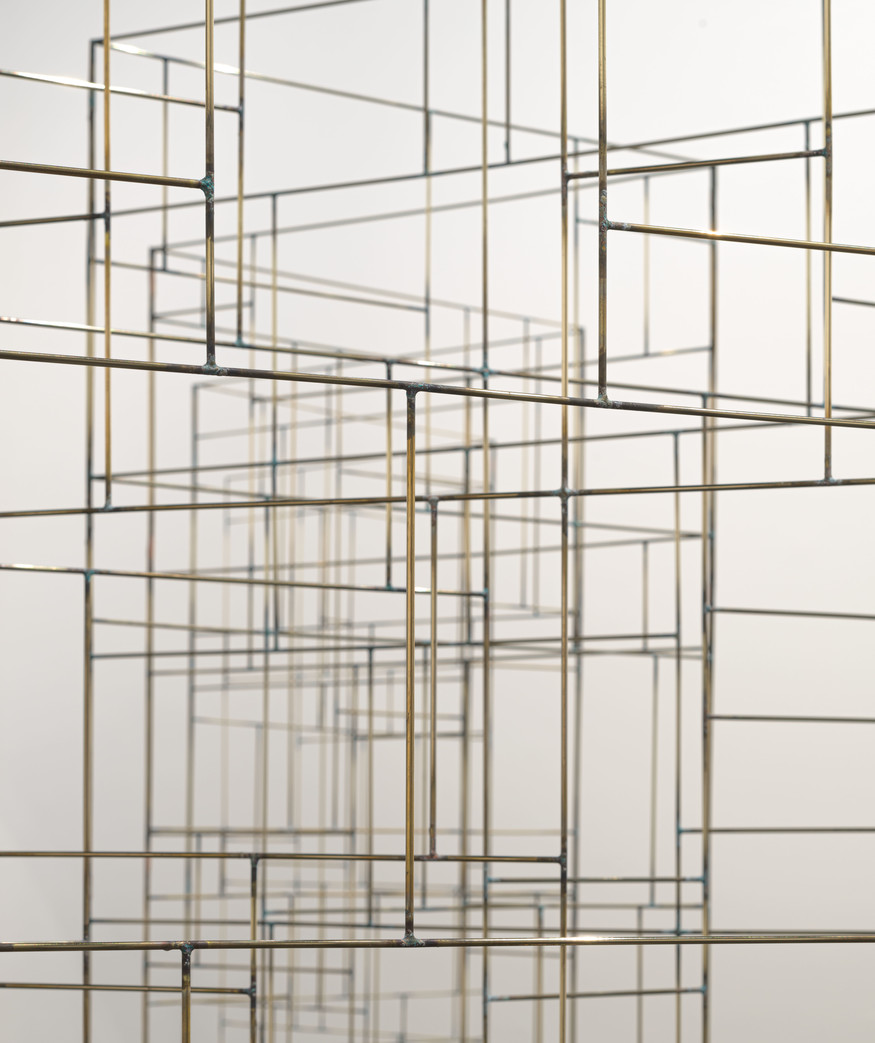
James Oram Screens (detail) 2022. Brass. Courtesy of the artist
For several years, Oram has used images of hands as a motif through which to link popular culture, technology and commerce with the human body and emotions. Similarly, in By Spectral Hands he has isolated hands from various advertisements and enlarged them to make a series of cyanotypes. Clustered into groups and set behind perspex, Oram’s blueprints appear to be schemes or plans too: intentional sets, perhaps gathered through an online image search. We incorporate hand movements into speech to add emphasis or assist in explanation, and in isolating the hands from advertising, with no sign of the background, context or products, we are forced to focus on the gestures as trends in body language. The open palms and guiding fingers gleaned from marketing here point towards an absent product offered for sale and so reinforce the overarching message of desirability. Hands are also about consumer choice in terms of grabbing, holding, having and taking, the ability to select and possess something.
Like the spectral hands of the exhibition’s title, these disembodied hands have a ghostly quality, which is enhanced by the monochromatic nature of Oram’s blueprints. The cyanotype process relies on UV light and results in high-contrast images that are a distinct watery blue colour. As with any photograph, we are looking at a moment from the past captured and preserved in print; an absence in the sense that they are lingering images of hands, displaced physically from the body and conceptually in time. The spectral hands, in their appearance and process of construction, make reference to what economist Adam Smith termed the “invisible hand” of the free market; the belief that society benefits from individuals acting in their own self-interests through a ‘trickle-down’ effect is a notion that is still used to justify neoliberalism.1
The ghostliness also draws into the exhibition ideas of hauntology, or the return or persistence of social and cultural elements from the past, which philosopher Jacques Derrida introduced in his 1993 book Specters of Marx and cultural theorist Mark Fisher related to popular music and culture. “What haunts the digital cul-de-sacs of the twenty-first century is not so much the past as all the lost futures that the twentieth century taught us to anticipate,” Fisher wrote, lamenting our inability to think of alternative futures, or indeed any way to exist other than capitalism.2 Theorists such as Paul Mason have made claims for Postcapitalism and future potential alternatives, yet we remain stubbornly tethered to free market ideology in our daily lives and politics. Oram’s cyanotypes visually hint at the trickery of Victorian photography, of the magic and conjuring associated with this early era of photography, yet the hands emerging out of the deep blue are also part of a contemporary lexicon. As a direct, non-verbal signal they seem to bridge times and cultures, caught somewhat out-of-time, at once no longer and not yet. And spooky all the same.
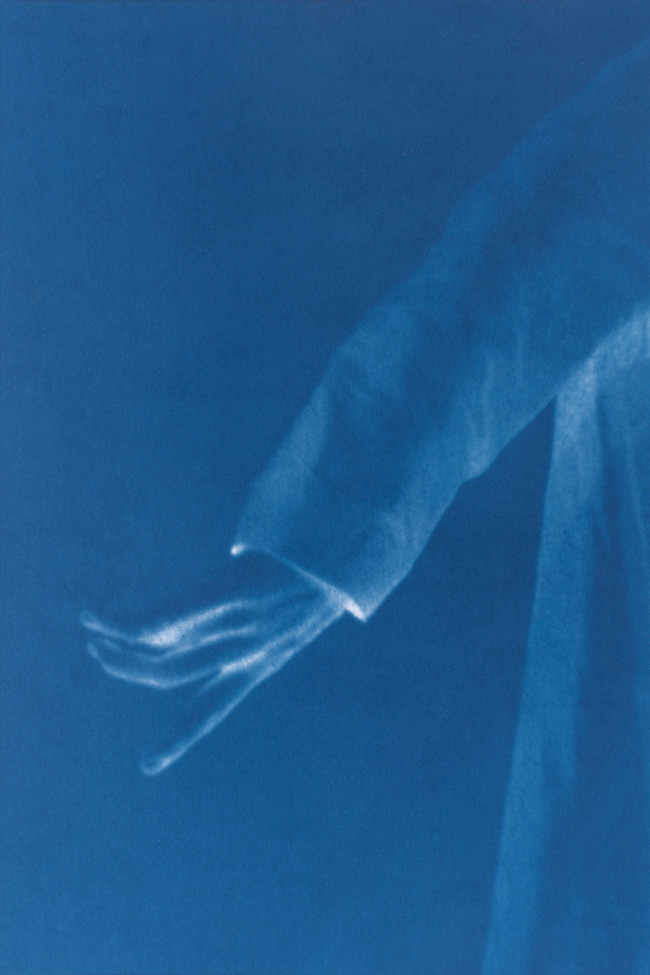
James Oram Spectral hands (detail) 2022. Cyanotype prints of found imagery. Courtesy of the artist
Another hand appears in a new two-channel video work depicting transitions between different physical states of water. Across the two screens, a frozen sculpture of a thumbs-up gradually melts, evaporates, condenses and refreezes, caught in an eternal loop. The stylised thumbs-up has become ubiquitous in contemporary culture, used liberally to show that we ‘like’ posts, comments and images online. Oram utilises a model of the sign here to consider our willing participation or complicity in global capitalism through social media; how as we happily endorse or respond to each other, we are simultaneously gifting information about ourselves, our preferences and desires to technology companies. At the same time, as we scroll through these apps, we are consuming a range of sponsored content that proliferates in the online feed generated for us by the computer algorithms that are constantly learning about us and proposing what we might want to see, support and buy. The word ‘feed’ in particular clarifies that this is a process of consumption, that we are being fed the constant stream of entertainment, products and opinions that have been collectively provided as digital content, filtered out and regurgitated across various media platforms. We are made aware of the powerful algorithms that drive our behaviour from behind the glossy surfaces and screens of contemporary life. Oram’s video tangibly embodies what Karl Marx wrote in the 1848 Communist Manifesto: “All that is solid melts into air, all that is holy is profaned, and man is at last compelled to face with sober senses his real conditions of life, and his relations with his kind.” Marx was comparing capitalism to earlier societal structures to stress that the constant change introduced through a free market economy and private ownership means social orders, hierarchies and forms of social organisation are also in constant flux; that capitalism melts or evaporates all things. The hypnotic simplicity of Oram’s translucent, optimistic thumbs-up melting away only to be reformed calls into question the sincerity of the gesture, echoing the conflicting emptiness and connectivity of social media and the precarious nature of contemporary life. So even though he does not necessarily intend to incorporate a Marxian perspective, we are prompted to think about the conditions of our everyday existence and how we relate to each other across both online and IRL experiences.
In the late-1940s, New Zealand economist Bill Phillips made the Monetary National Income Analogue Computer (MONIAC) to simulate economic phenomena and used water flow as the calculating medium. It’s a fascinating model that was brought to fame in the art world by artist Michael Stevenson. Oram’s work here similarly provides a simplified sculptural rendition of economic ideas in terms of marketing and consumer behaviour, succinctly acknowledging how the information age complicates capitalism; since digital goods and services do not have the same limitations and scarcity as other products, technology companies have had to find innovative ways to control supply in the market.3
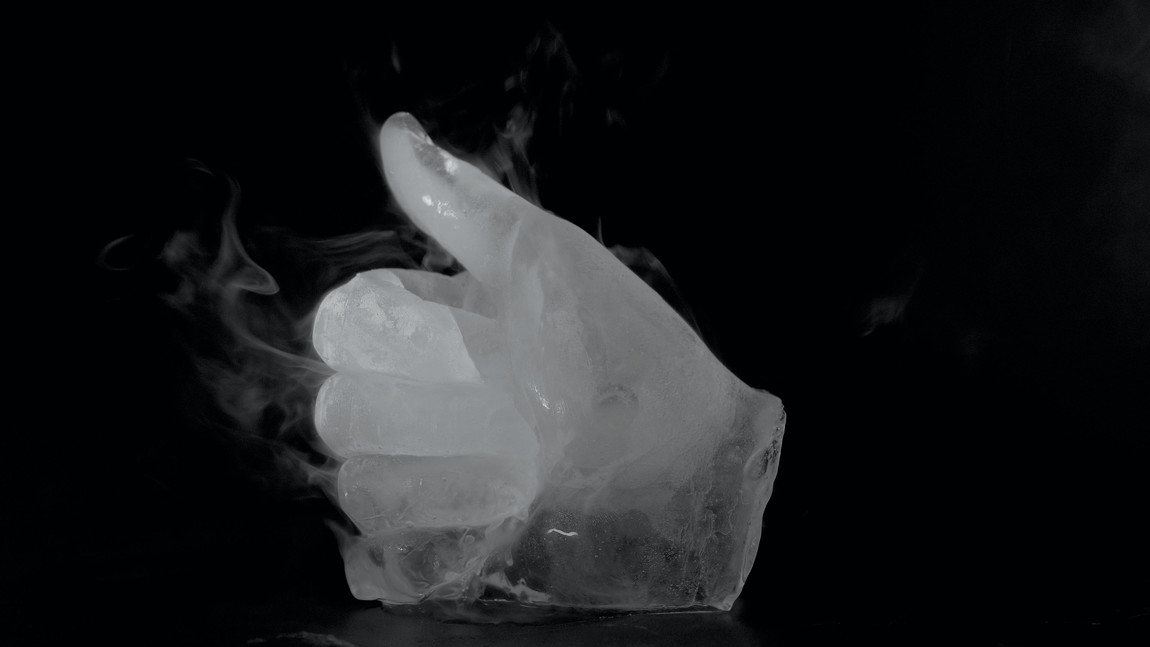
James Oram Currency (video still) 2022. Two-channel 4K video. Courtesy of the artist
The works in By Spectral Hands allude to capitalist substructures and our place as consumers within them through watery transitions, blueprints and explorations of marketing strategies. As we face the looming climate crisis and the monumental changes to society that are necessary for our survival, discussion around economics, commerce and governance is more pressing than ever. Why do we still allow the free market to decide all things? Can we as consumers contribute to change? Oram leaves questions like these hanging, not taking sides or offering solutions, but identifying the peculiarities of the current state we have all agreed to live in… for now.








